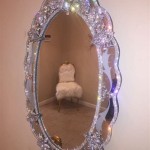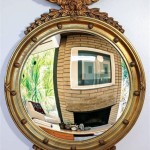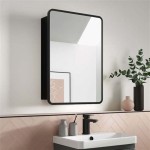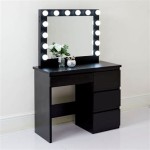Mirrored Frame Wall Mirror: An Exploration of Design and Function
Mirrored frame wall mirrors have become increasingly popular as both decorative and functional elements in interior design. These mirrors, characterized by frames constructed primarily or entirely of mirrored glass, offer a unique aesthetic that distinguishes them from traditional framed mirrors. This article will explore the characteristics, design considerations, applications, and benefits of mirrored frame wall mirrors, providing a comprehensive overview of their place in modern interiors.
Understanding the Anatomy of a Mirrored Frame Wall Mirror
A mirrored frame wall mirror is fundamentally composed of two key elements: the central mirror itself and the mirrored frame that surrounds it. The central mirror is typically made of high-quality float glass, treated with a reflective coating, generally silver or aluminum, on the back surface. This coating is then protected by layers of paint or lacquer to prevent oxidation and degradation, ensuring longevity and clarity of reflection. The size and shape of the central mirror can vary considerably, ranging from small, decorative pieces to large, full-length mirrors designed to serve a more practical purpose.
The frame, however, is the defining characteristic of this type of mirror. This frame is constructed from smaller sections of mirrored glass, precisely cut and assembled to create a cohesive border around the central mirror. The individual segments of the mirrored frame can be arranged in a variety of patterns, influencing the overall aesthetic of the piece. Common designs include uniform strips of mirror, geometric patterns, beveled edges, and even more elaborate mosaic-like designs. The frame’s width also varies, ranging from slim, minimalist borders to thicker, more substantial frames that make a bolder statement.
The construction of a mirrored frame wall mirror requires precision and craftsmanship. The mirrored glass used for the frame must be accurately cut to the specified dimensions to ensure a seamless and visually appealing finish. These pieces are then meticulously adhered to a backing material, often wood or MDF (Medium-Density Fiberboard), which provides structural support and stability to the entire assembly. The adhesive used must be specifically formulated for use with glass and mirrors to prevent damage to the reflective coating and ensure a secure bond over time. The edges of the mirrored frame are often polished or beveled to eliminate sharp edges and enhance the overall visual appeal.
Design Considerations for Mirrored Frame Wall Mirrors
When incorporating a mirrored frame wall mirror into an interior design, several factors should be taken into consideration. These include the overall style of the room, the size and shape of the mirror, the placement of the mirror, and the surrounding lighting conditions. Careful consideration of these factors will ensure that the mirror enhances the space and complements the existing decor.
The style of the room is a crucial factor in selecting the appropriate mirrored frame wall mirror. In modern and contemporary spaces, mirrors with clean lines, geometric patterns, and minimalist frames are often preferred. These designs can complement the sleek and uncluttered aesthetic of these spaces. Conversely, in more traditional or glamorous settings, mirrors with more ornate frames, beveled edges, and intricate detailing may be more appropriate. The frame's pattern and finish should align with the room's overall design theme, whether it be classic, art deco, or Hollywood Regency.
The size and shape of the mirror should be chosen based on the intended function and the available wall space. Smaller mirrors are ideal for adding subtle accents and creating a sense of depth in smaller rooms or hallways. Larger mirrors, on the other hand, can make a bolder statement and visually expand the room's dimensions. The shape of the mirror can also impact the overall aesthetic. Rectangular mirrors are versatile and can be used in most spaces, while round or oval mirrors can add a softer, more organic feel. Unusual or asymmetrical shapes can create a focal point and add a touch of individuality to the design.
The placement of the mirror is critical to maximizing its impact. Mirrors should be positioned to reflect natural light or key design elements, such as artwork or furniture. Placing a mirror opposite a window can dramatically increase the amount of natural light in a room, making it feel brighter and more spacious. Mirrors can also be used to create the illusion of symmetry by reflecting architectural features or furniture arrangements. Avoid placing mirrors in locations where they will reflect cluttered areas or unflattering views, as this can detract from the overall aesthetic of the space.
Lighting conditions also play a crucial role in how a mirrored frame wall mirror is perceived. Adequate lighting is essential to ensure that the mirror provides a clear and accurate reflection. Consider adding lighting fixtures specifically designed to illuminate the mirror, such as sconces or vanity lights. These fixtures should provide soft, even lighting that minimizes shadows and glare. The color temperature of the lighting should also be considered, as warm lighting can create a more inviting and flattering reflection, while cool lighting can provide a more crisp and modern look. The mirrored frame itself will also reflect light, so its placement relative to light sources is important to avoid excessive glare.
Applications and Benefits of Mirrored Frame Wall Mirrors
Mirrored frame wall mirrors find applications in a wide range of interior spaces, each offering specific benefits and serving diverse purposes. From bathrooms and bedrooms to living rooms and hallways, these mirrors can enhance the aesthetics and functionality of any room. Their versatility and adaptability make them a valuable addition to any interior design scheme.
In bathrooms, mirrored frame wall mirrors are commonly used above vanities to provide a functional and stylish reflective surface for grooming and personal care tasks. The mirrored frame can add a touch of elegance and sophistication to the bathroom decor, complementing the vanity, fixtures, and other accessories. The size and shape of the mirror should be chosen based on the size of the vanity and the available wall space. Consider adding lighting fixtures above or to the sides of the mirror to provide ample illumination for grooming tasks. Mirrors with built-in LED lighting are also a popular option, offering energy-efficient and customizable lighting solutions.
In bedrooms, mirrored frame wall mirrors can be used as statement pieces to add drama and visual interest to the space. A large, full-length mirror can be placed against a wall to create the illusion of more space and reflect natural light. Smaller mirrors can be used as decorative accents, placed above a dresser or bedside table. Mirrors with ornate frames or unique shapes can add a touch of personality and style to the bedroom decor. The placement of the mirror should be carefully considered to avoid reflecting unflattering views or disrupting the flow of the room.
In living rooms, mirrored frame wall mirrors can be used to create a focal point and enhance the overall ambiance of the space. A large mirror can be placed above a fireplace or sofa to reflect natural light and visually expand the room's dimensions. Smaller mirrors can be grouped together to create a gallery wall or used to highlight architectural features. The style of the mirror should complement the existing furniture and decor. Consider adding accent lighting to highlight the mirror and create a warm and inviting atmosphere. The reflective surfaces will amplify the lighting, creating a brighter and more open feel.
In hallways and entryways, mirrored frame wall mirrors can be used to brighten up the space and create a welcoming atmosphere. A mirror placed near the entrance can provide a convenient place to check one's appearance before leaving the house. The reflective surface can also help to make the hallway feel more spacious and less claustrophobic. Consider adding a console table or bench beneath the mirror to create a functional and stylish entryway. The mirrored frame can add a touch of elegance and sophistication to the hallway decor.
Beyond their aesthetic appeal, mirrored frame wall mirrors offer several functional benefits. They can visually expand the dimensions of a room, making it feel larger and more spacious. They can reflect natural light, brightening up dark corners and creating a more inviting atmosphere. They can also be used to create the illusion of depth, making a room feel less constricted. Mirrors are also relatively easy to clean and maintain, requiring only occasional wiping with a soft cloth and glass cleaner. The durable construction of mirrored frame wall mirrors ensures that they will last for many years, providing long-lasting beauty and functionality.

Evelyn Mirrored Frame Silver Square Wall Mirror

Tetote Black Framed Mirrors For Bathroom 22 X 30 Inch Brushed Metal Frame Wall Mounted Rectangle Mirror Vanity Horizontal Vertical Com

Mirrored Frames Transitional Living Room Mirrors Rooms On Wall

Mirror Framed Wall 130 639 Afw Com

Home Art Deco Rectangle 3d Pieces Of Small Mirrors Frame Wall Silver Mirror China Morror Made In Com

Manor Brook Leland 34 In X Modern Round Mirrored Frame Wall Mirror Mb100572 The Home Depot

Buy Multicoloured Mirrors For Home Kitchen By 999 Ajio Com

Triple Arched Frame Wall Mirror West Elm

Possini Euro Design Clafia Rectangular Vanity Wall Mirror Modern Beveled Edge Clear Diamond Mirrored Frame 26 Wide For Bathroom Bedroom Living Room Com

Possini Euro Design Clafia Rectangular Vanity Wall Mirror Modern Beveled Edge Clear Diamond Mirrored Frame 26 Wide For Bathroom Bedroom Living Room Target








